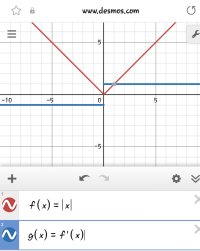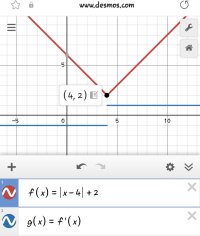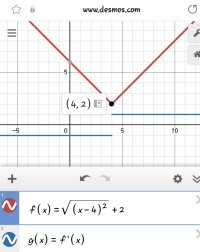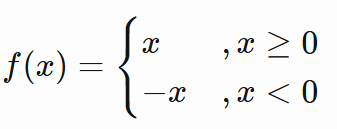Agent Smith
Full Member
- Joined
- Oct 18, 2023
- Messages
- 348
[imath]f(x) = |x|[/imath]
[imath]g(x) = f'(x)[/imath]
I didn't know that [imath]f(x)[/imath] was differentiable except when [imath]x = 0[/imath].
What if the point [imath](0, 0)[/imath] were important to me? It IS a minimum, could become a maximum under transformation.
Say a transformation of the absolute value function gives us the error E in some computation and I want to find the condition for min/max error. I won't be able to find the derivative, equate it to 0, and so on.
Say error [imath]E = |x - 4| + 2[/imath]. Do I do this:
E will be minimum when [imath]x - 4 = 0 \implies x = 4[/imath].
Do I do this [imath]E = \sqrt {(x - 4)^2} + 2[/imath]
Then [imath]\frac{dE}{dx} = \frac{1}{2} (x -4)^{-1} 2(x - 4) = 1[/imath]. Then that would mean there's no minimum since [imath]1 \ne 0[/imath]


[imath]g(x) = f'(x)[/imath]

I didn't know that [imath]f(x)[/imath] was differentiable except when [imath]x = 0[/imath].
What if the point [imath](0, 0)[/imath] were important to me? It IS a minimum, could become a maximum under transformation.
Say a transformation of the absolute value function gives us the error E in some computation and I want to find the condition for min/max error. I won't be able to find the derivative, equate it to 0, and so on.
Say error [imath]E = |x - 4| + 2[/imath]. Do I do this:
E will be minimum when [imath]x - 4 = 0 \implies x = 4[/imath].
Do I do this [imath]E = \sqrt {(x - 4)^2} + 2[/imath]
Then [imath]\frac{dE}{dx} = \frac{1}{2} (x -4)^{-1} 2(x - 4) = 1[/imath]. Then that would mean there's no minimum since [imath]1 \ne 0[/imath]




